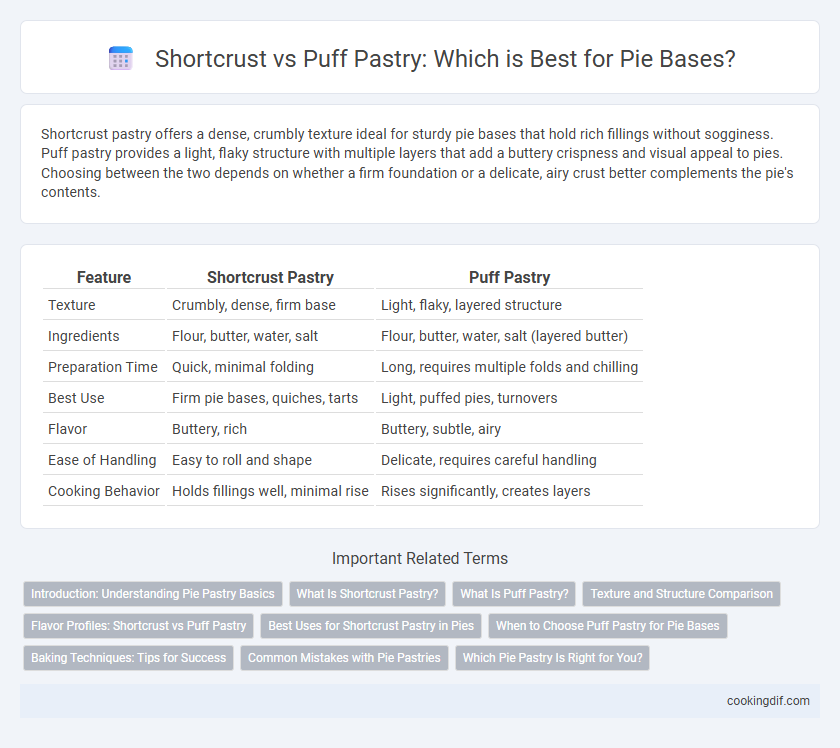Shortcrust pastry offers a dense, crumbly texture ideal for sturdy pie bases that hold rich fillings without sogginess. Puff pastry provides a light, flaky structure with multiple layers that add a buttery crispness and visual appeal to pies. Choosing between the two depends on whether a firm foundation or a delicate, airy crust better complements the pie's contents.
Table of Comparison
| Feature | Shortcrust Pastry | Puff Pastry |
|---|---|---|
| Texture | Crumbly, dense, firm base | Light, flaky, layered structure |
| Ingredients | Flour, butter, water, salt | Flour, butter, water, salt (layered butter) |
| Preparation Time | Quick, minimal folding | Long, requires multiple folds and chilling |
| Best Use | Firm pie bases, quiches, tarts | Light, puffed pies, turnovers |
| Flavor | Buttery, rich | Buttery, subtle, airy |
| Ease of Handling | Easy to roll and shape | Delicate, requires careful handling |
| Cooking Behavior | Holds fillings well, minimal rise | Rises significantly, creates layers |
Introduction: Understanding Pie Pastry Basics
Shortcrust pastry features a crumbly, tender texture ideal for sturdy pie bases, made from flour, fat, and minimal water, ensuring a rich, buttery flavor. Puff pastry consists of multiple thin layers created by folding butter into dough, producing a light, flaky crust that rises during baking. Choosing between shortcrust and puff pastry depends on the desired pie texture and structural support for fillings, with shortcrust offering firmness and puff pastry providing a delicate crispness.
What Is Shortcrust Pastry?
Shortcrust pastry is a classic pie base made from a simple mixture of flour, fat (usually butter), and water, creating a crumbly and tender texture that holds fillings well without puffing up. Its low moisture content prevents rising, ensuring a sturdy, crisp crust ideal for both sweet and savory pies. Renowned for its ease of handling and stable structure, shortcrust pastry contrasts with puff pastry by offering a dense, melt-in-the-mouth base rather than layered flakiness.
What Is Puff Pastry?
Puff pastry is a laminated dough made by layering butter and dough through repeated folding and rolling, creating multiple flaky, airy layers. It rises dramatically in the oven due to steam generated from the butter, resulting in a crisp, delicate texture ideal for light, buttery pie bases and pastries. Unlike shortcrust pastry, puff pastry is not as dense or crumbly but provides a light and voluminous structure perfect for both sweet and savory pies.
Texture and Structure Comparison
Shortcrust pastry offers a firm, crumbly texture that provides a sturdy base ideal for holding wet pie fillings without becoming soggy. Puff pastry features a light, flaky structure created by layers of butter and dough, resulting in an airy, delicate crust that rises significantly during baking. The dense composition of shortcrust enhances structural integrity, while puff pastry's multiple laminated layers emphasize crispness and tenderness in pie bases.
Flavor Profiles: Shortcrust vs Puff Pastry
Shortcrust pastry offers a rich, buttery flavor and a tender, crumbly texture that provides a stable base for pies, enhancing savory or sweet fillings with its subtle, slightly sweet taste. Puff pastry delivers a light, flaky, and layered structure with a buttery, delicate flavor that adds a crisp contrast to fillings, often elevating the overall pie experience with its airy texture. The choice between shortcrust and puff pastry depends on whether a denser, melt-in-the-mouth base or a crisp, flaky topping is desired to complement the pie's flavor profile.
Best Uses for Shortcrust Pastry in Pies
Shortcrust pastry offers a sturdy, crumbly texture ideal for pies requiring a firm base to hold heavier fillings such as quiches, meat pies, and dense fruit tarts. Its rich, buttery flavor enhances savory and sweet pies without overwhelming delicate ingredients. Best used for recipes needing structural integrity, shortcrust pastry prevents sogginess and supports layered fillings effectively.
When to Choose Puff Pastry for Pie Bases
Puff pastry is ideal for pie bases when a light, flaky texture and layered crispness are desired, especially in savory dishes like meat or vegetable pies that benefit from a buttery, airy crust. Its high butter content and multiple folds create distinct, delicate layers that rise and separate during baking, adding visual appeal and a contrasting texture to rich fillings. Choose puff pastry for pies where an elegant, golden crust enhances both presentation and the overall eating experience.
Baking Techniques: Tips for Success
Shortcrust pastry requires gentle handling and minimal water to maintain a crumbly texture, with thorough chilling before rolling to prevent shrinking during baking. Puff pastry demands precise folding and multiple turns to create its signature flaky layers, and keeping the dough cold is essential to achieve optimal rise and texture. Blind baking both pastry types with pie weights ensures a crisp base, while oven temperature control prevents overbrowning or soggy bottoms.
Common Mistakes with Pie Pastries
Common mistakes with pie pastries include overworking shortcrust dough, which leads to toughness instead of a tender, crumbly base, and under-chilling puff pastry, causing it to lose its layers and flakiness. Using too much water in shortcrust can make the dough sticky and difficult to handle, while failing to roll puff pastry evenly results in uneven rising and texture. Proper handling, temperature control, and ingredient ratios are crucial to achieving the ideal crispness and structure in both shortcrust and puff pastry pie bases.
Which Pie Pastry Is Right for You?
Shortcrust pastry offers a firm, crumbly texture ideal for savory and sweet pies requiring a sturdy base, such as quiches and apple pies. Puff pastry provides a light, flaky, and buttery layer perfect for decorative tops or delicate desserts like fruit tarts. Choose shortcrust for reliability and structural support, while puff pastry excels in elevating texture and visual appeal.
Shortcrust vs Puff Pastry for pie bases Infographic

 cookingdif.com
cookingdif.com